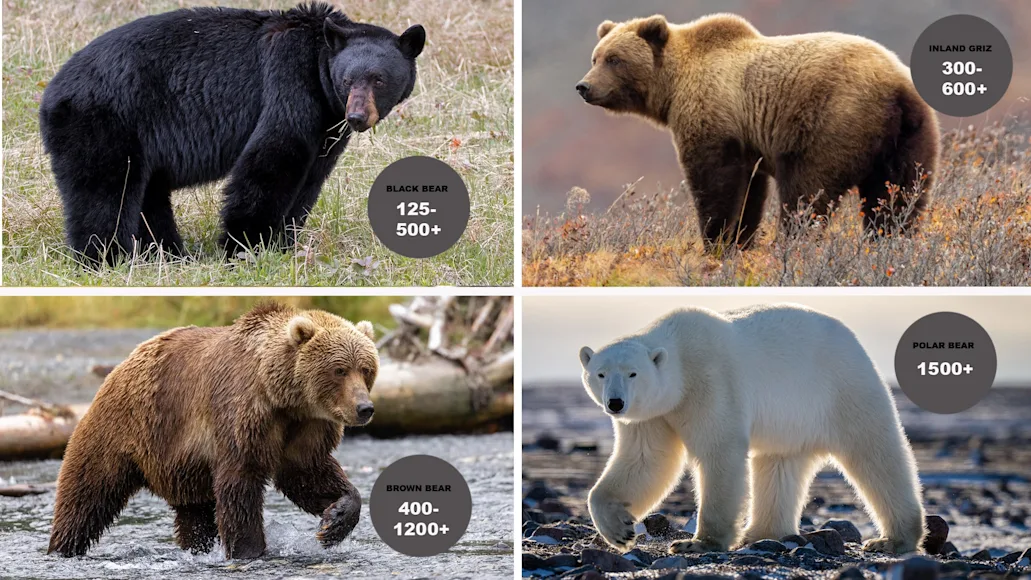So, you’re wondering, How much does a bear weigh? It’s a simple enough question, but the answer can get a little complicated, seeing that it depends on the bear’s age, species, locale, time of year, and more. But don’t worry. Whether you’re stressing over that backcountry elk hunt in Griz Country or wondering how long the post that holds your bird feeder will hold up the suburban bruin climbing up it, you’ve come to the right place.
Bears have always fascinated humans with their sheer size and strength, and recent evidence has shown that Neanderthals hunted and consumed bears
long before Homo sapiens roamed the earth. In the modern age, bears are the largest land predators in North America and can weigh anywhere from around 100 pounds to well over 1,500 pounds. That’s a wide range, however, so let’s break down the question of how much does a bear weigh by North American species.
The Bear Species of North America
Four species of bears call North America home: black bears, inland grizzlies, coastal brown bears, and polar bears, from smallest to largest. Male black bears typically weigh between 125 to 500 pound, while females usually weigh between 100 to 300 pounds. Inland grizzlies average 300 to 600 pounds depending on gender. Adult coastal browns usually run between 400 to over 1,200 pounds. And, lastly, the average adult polar bears tip the scales at around 1,500 pounds, which is whole lot of bear. Here’s a quick-guide visual breakdown:
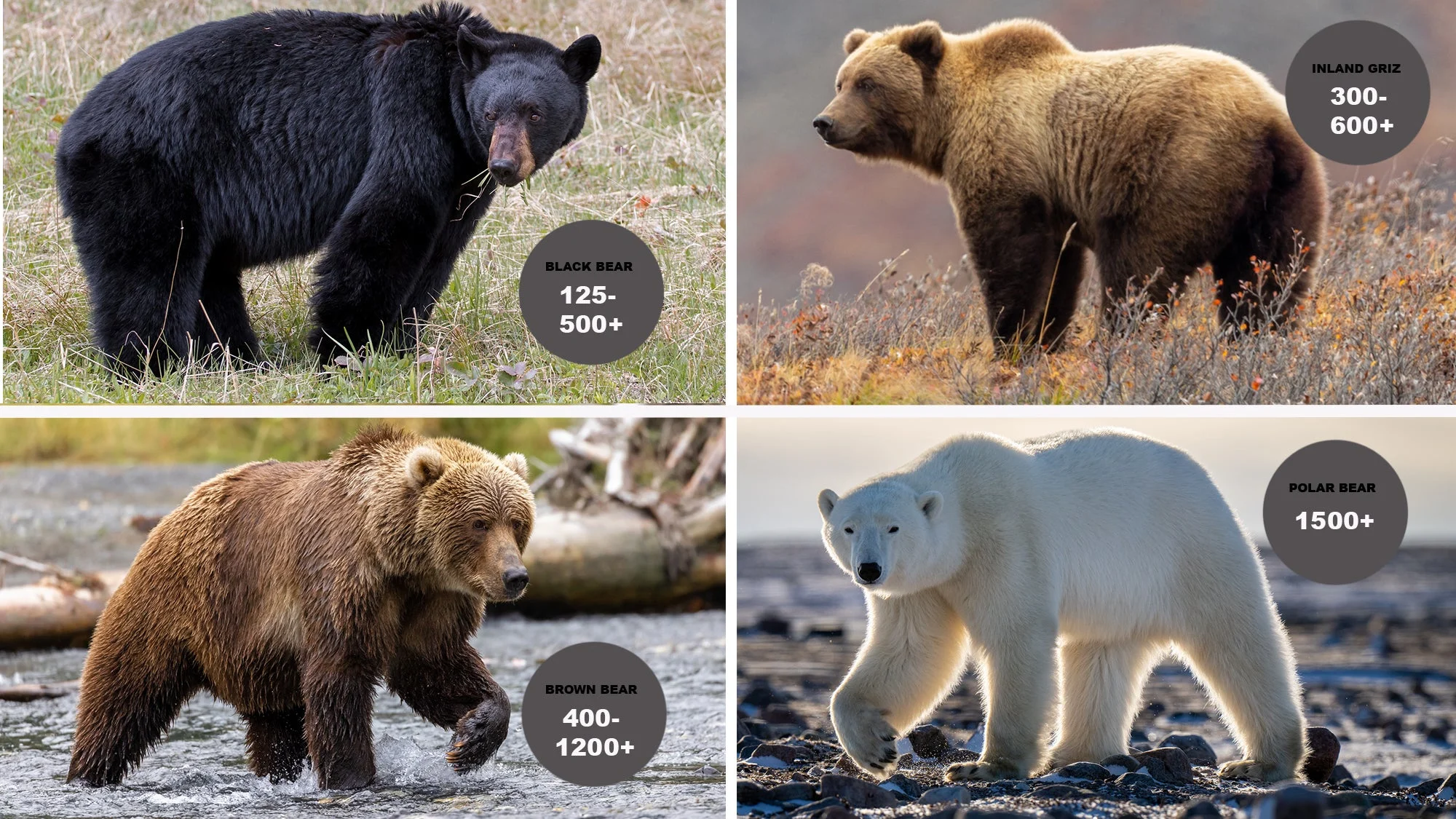
Adobe Stock / Field & Stream
How Much Does a Black Bear Weigh?
Black bears are the smallest of the North American bear species and can range wildly in size. Despite the name, black bears can come in a variety of colors, including brown, blonde, and even white. No matter their color, they are all still Ursus americanus—which is to say, black bears. Just trust me on this part.

Any black bear over 500 pounds is giant, but the biggest ever went 900-plus. Adobe Stock
Black bears can be found in every Canadian province and about 40 US states. Secluded populations can also be found in certain parts of Mexico. Their size can fluctuate drastically through the year, with bears losing as much as 30 percent of their body weight during hibernation. The biggest black bear ever harvested was killed in New Brunswick in 1972 and weighed over 900 pounds field dressed.
If you’re looking to spot some of the biggest black bears on the continent, head to Alaska or Canada where they can reach their maximum size due to abundant food sources and fewer predators, but of all places, Pennsylvania dominates the Boone & Crockett record books with four of the eight largest black bear entries.
How Much Does an Inland Grizzly Weigh?
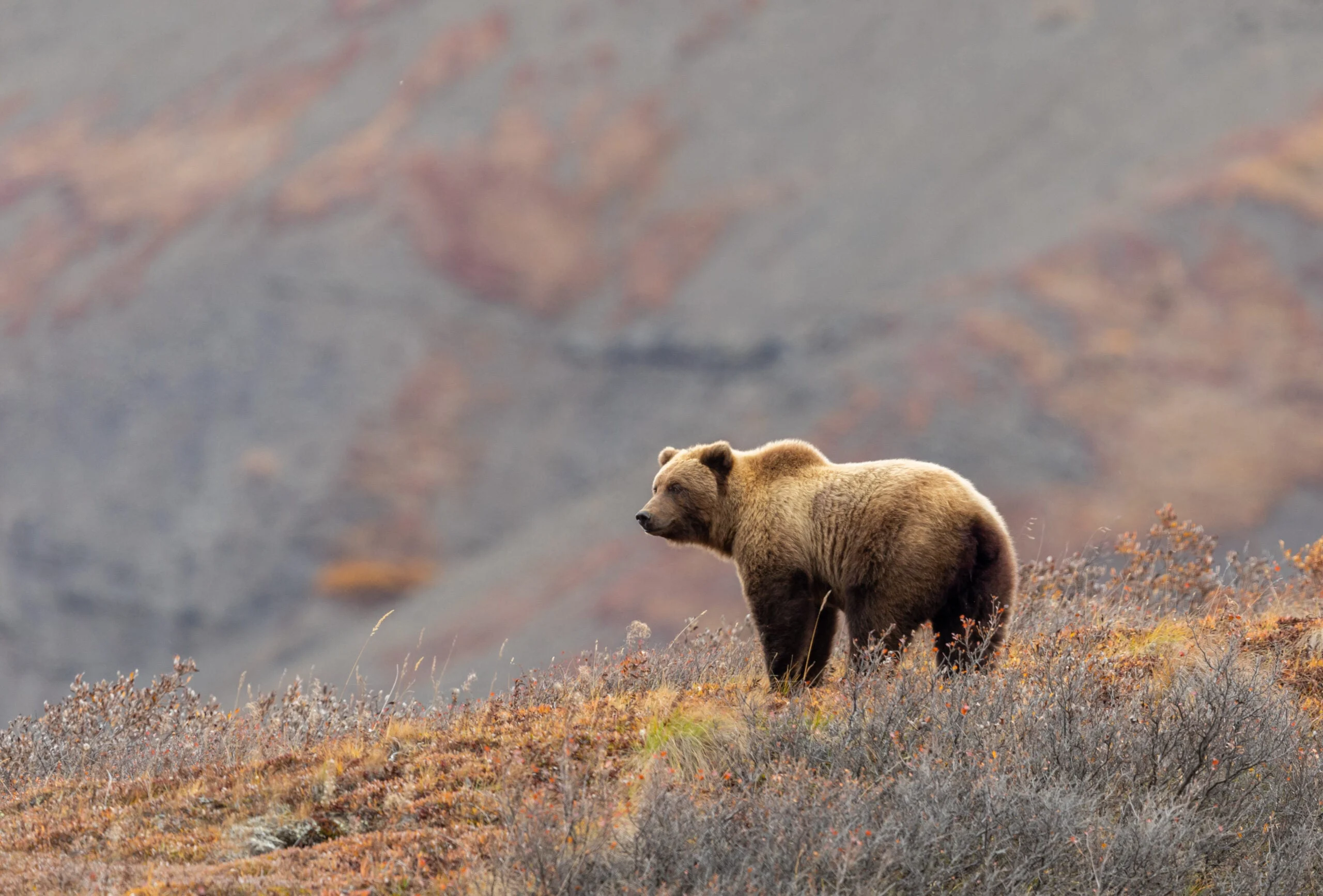
Inland grizzlies can top 1,000 pounds, but are typically in the 300 to 600-pound range. Adobe Stock
Inland grizzly bears are the second-smallest bears in North America, but if you’ve seen The Revenant, you know that this statement is relative. These bears still weigh as much or more than a Booner bull elk and are known for their distinct shoulder hump and aggressive nature and can easily make mincemeat out of you whether you’re Hugh Glass or a hiker with a man-bun. They live in the northern Rockies of Western Canada, all of inland Alaska, parts of Idaho and Montana, and all of the Greater Yellowstone Ecosystem.
Male inland grizzlies typically weigh between 600 to 1,000 pounds while females average between 300 and 700 pounds. However, these numbers can vary greatly depending on the location and the bear’s food sources. All bears are omnivorous and can digest a variety of nutrition. While grizzlies eat large prey animals, such as moose and elk, when available, a major portion of their diet comes from nuts, berries, tubers, worms, and even grasses and insects.
If you’re looking to spot some of the biggest inland grizzlies, head to the flatter inland portions of Alaska. Generally speaking, mountain bears struggle to find as much nutrition as flatlanders, which often grow larger as a result.
How Much Does a Coastal Brown Bear Weigh?
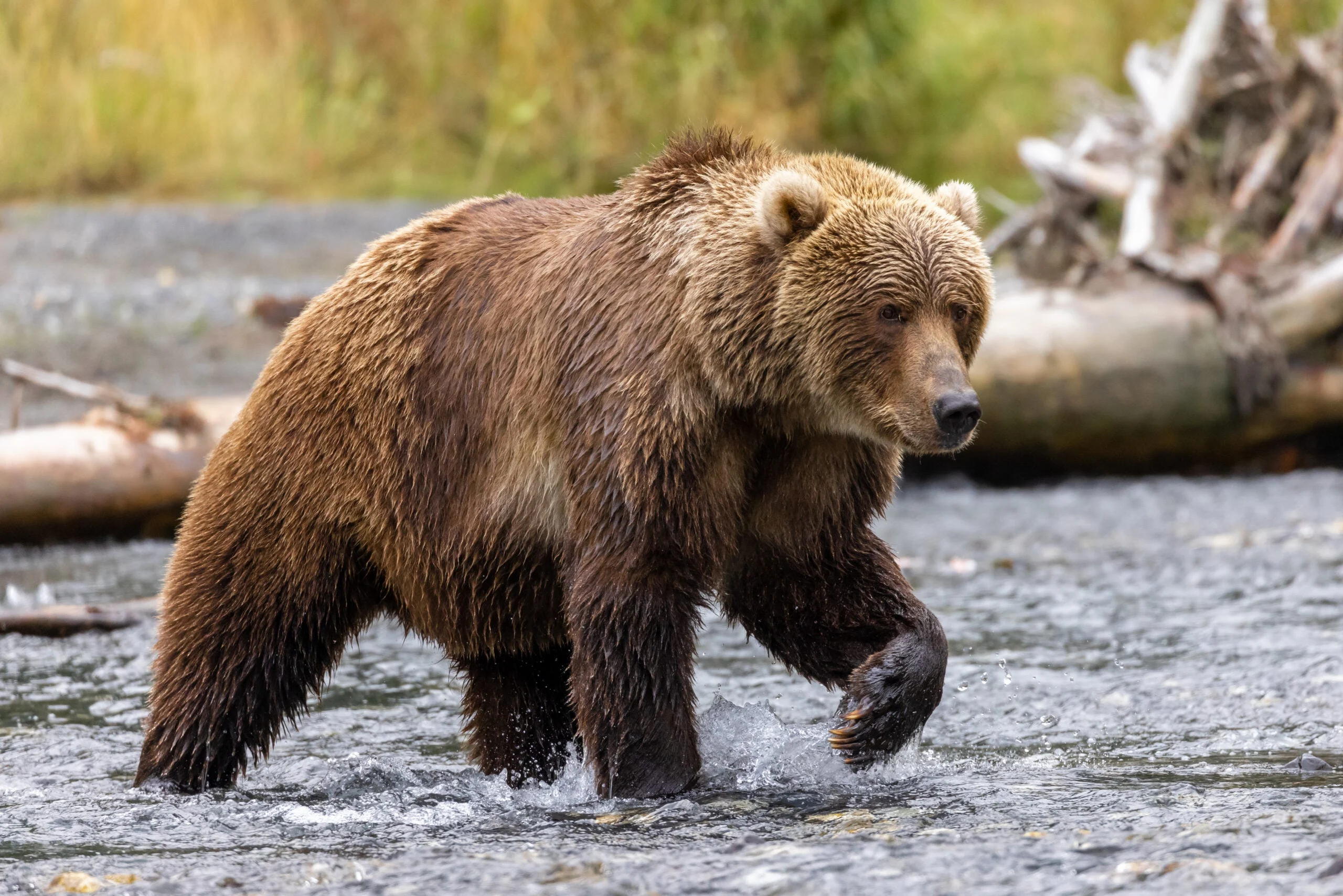
Massive coastal brown bears, like this one on Kodiak Island, can top 1,600 pounds. Mark A. McCaffrey / Adobe Stock
Coastal brown bears, also known as Alaskan brown bears, are anatomically identical to inland grizzlies. In fact, they share the same genus and species but are recognized as a distinct subspecies, due to their unique differences in diet and behavior. Most hunters and outdoorsmen consider them separate, too, do to their size differences and markedly different habitats. These bears are found along the coast of Alaska and Canada and are omnivorous like their inland cousins. However, every summer, coastal brown bears famously gorge themselves on fish, predominantly spawning salmon, to pack on weight for the long winters—a meal most inland grizzlies can only dream about while sucking down tubers.
Male coastal brown bears commonly weigh from 800 to 1,200 pounds, while females are generally between 400 to 700 pounds. The largest recorded wild male weighed over 1,600 pound and at over 9 feet tall, could almost hit his head on a basketball goal when standing upright. Sixteen out of the 20 largest brown bears ever killed have come from Kodiak Island, Alaska, or the surrounding islands.
How Much Does Polar Bear Weigh?
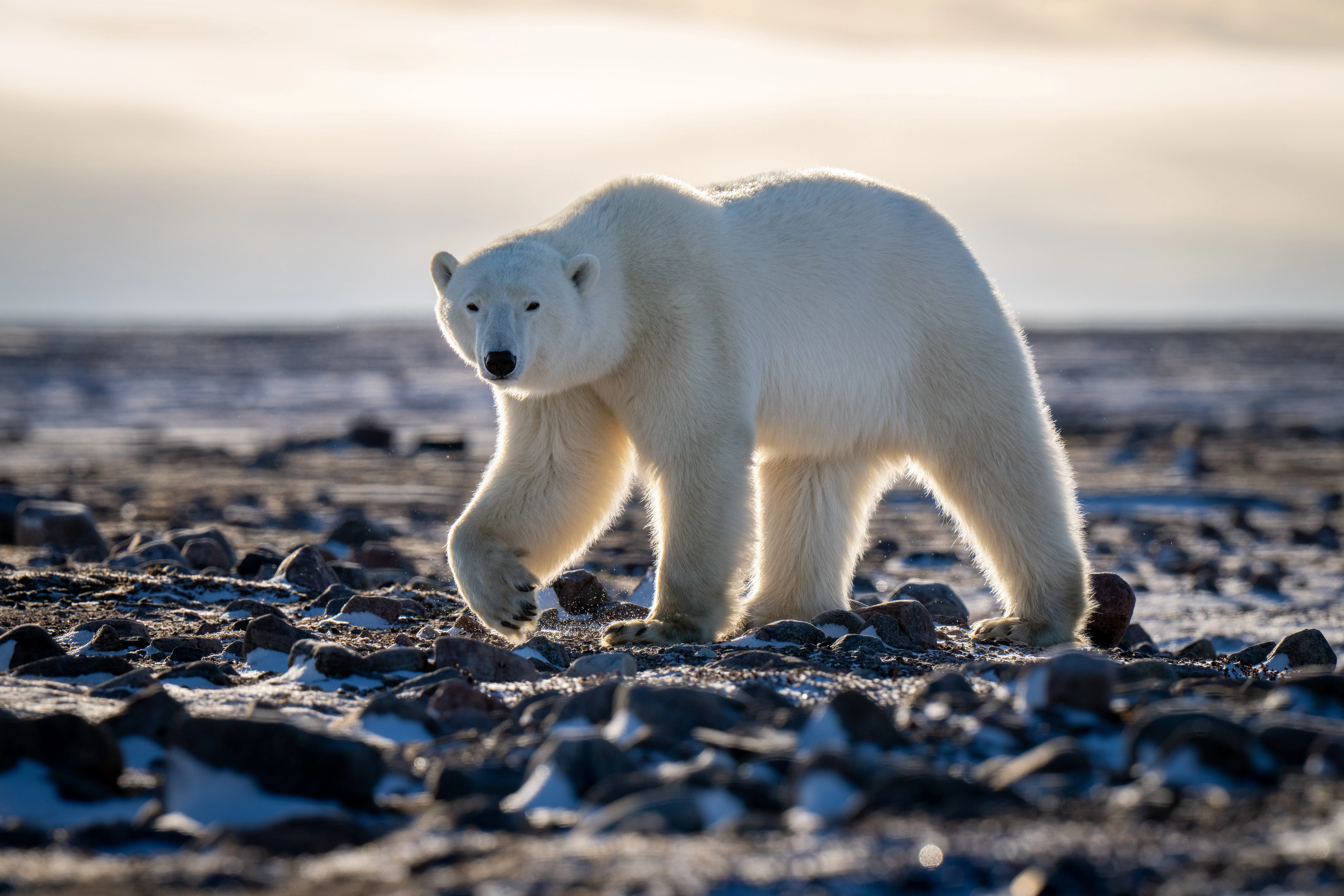
Polar bears are the largest of all the North American bear species. Nick Dale / Adobe Stock
Males commonly exceed 1,500 pounds, more than a Shiras moose, while females typically top out around 700. If you’re interested in seeing these impressive creatures in their natural habitat, you have to head north…way north. Polar bears only live in the Arctic regions of Alaska and Canada, as well as Greenland, Scandinavia, and Russia. Just make sure to keep a distance as polar bears are known to be fierce predators and can run over 25 mph. As of now, only native people can hunt them with some native populations still surviving through subsistence hunting, primarily of polar bears, whales, and seals.
Final Thoughts on Bear Weights
So there you have it—the average and top weights of North America’s bears. Just keep in mind that these weights can vary greatly depending on a variety of factors. So, if you’re still stressing about sleeping in Grizz Country, maybe focus on the fact that any bear that meanders into camp could be much smaller than you probably imagine. (It could be much larger, too, of course, but don’t focus that.) And finally, if you’re ever meeting someone for the first time and aren’t sure what to say, try “Hey, how much does a polar bears weigh? Enough to break the ice. Hi I’m (your name).” You’re welcome. No charge for that one.

